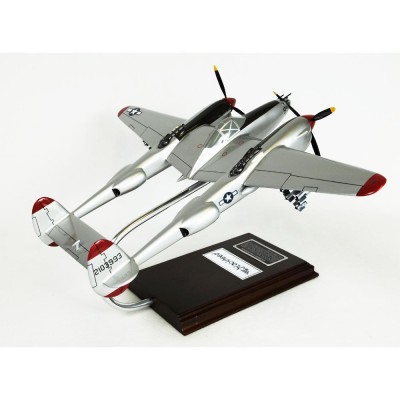1-877-795-2278 | info@aircraftspruce.ca
Aircraft Spruce Canada
Brantford, ON Canada
Corona, CA | Peachtree City, GA
Chicago, IL | Wasilla, AK
Aircraft Spruce Canada
Brantford, ON Canada
Corona, CA | Peachtree City, GA
Chicago, IL | Wasilla, AK
SAME DAY SHIPPING ON ORDERS PLACED BY 2 PM | 877-795-2278
Lockheed P-38 Lightning
$403.00/Each
Part# 13-10559
MFR Model# AP38B
MFR Model# AP38B
Overview
|
The Lockheed P-38 Lightning was a World War II American fighter aircraft. The P-38 was used most extensively and successfully in the Pacific Theater of Operations and the China-Burma-India Theater of Operations, where it was flown by the American pilots with the highest number of aerial victories to this date. Americas top ace Richard Bong earned 40 victories (in a lightning he called Marge) and Thomas McGuire scored 38 (in Pudgy). The P-38 Lightning was designed in 1937 as a high-altitude interceptor. The P-38 was the only American fighter aircraft in active production throughout the duration of American involvement in the war, from Pearl Harbor to VJ Day. The P-38 introduced a new dimension to American fighters - a second engine. The multi-engine configuration reduced the Lightning loss rate to anti-aircraft gunfire during ground attack missions. As with any long-term production aircraft, the P-38 underwent many modifications. The fastest of the modifications was the P-38J with a top speed of 420 mph and the version produced in the greatest quantity was the ""L,"" of which 3,735 were built by Lockheed and 113 by Vultee. The P-38M was a two-seat radar-equipped night fighter, a few of which had become operational before the war ended. The P-38 was the Armys fastest and most heavily armed fighter. The concentration of firepower in the Lightnings nose was so effective that a one-second burst could destroy an enemy plane. In the Pacific Theater, Lightning pilots downed more Japanese aircraft than pilots flying any other allied plane. By the end of production in 1945, 9,923 P-38s had been built. Only 27 of the aircraft exist today. |
Q&A
Please note, Aircraft Spruce Canada's personnel are not certified aircraft mechanics and can only provide general support and ideas, which should not be relied upon or implemented in lieu of consulting an A&P or other qualified technician. Aircraft Spruce Canada assumes no responsibility or liability for any issue or problem which may arise from any repair, modification or other work done from this knowledge base. Any product eligibility information provided here is based on general application guides and we recommend always referring to your specific aircraft parts manual, the parts manufacturer or consulting with a qualified mechanic.

 Aircraft Spruce Canada
Aircraft Spruce Canada















